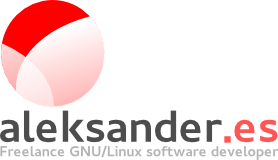Blog Archives
Naming devices in ModemManager

No more “which is now the index of this modem…?”
DBus object path and index
When modems are detected by ModemManager and exposed in DBus, they are assigned an unique DBus object path, with a common prefix and a unique index number, e.g.:
/org/freedesktop/ModemManager1/Modem/0
This path is the one used by the mmcli command line tool to operate on a modem, so users can identify the device by the full path or just by the index, e.g. this two calls are totally equivalent:
$ mmcli -m /org/freedesktop/ModemManager1/Modem/0 $ mmcli -m 0
This logic looks good, except for the fact that there isn’t a fixed DBus object path for each modem detected: i.e. the index given to a device is the next one available, and if the device is power cycled or unplugged and replugged, a different index will be given to it.
EquipmentIdentifier
Systems like NetworkManager handle this index change gracefully, just by assuming that the exposed device isn’t the same one as the one exposed earlier with a different index. If settings need to be applied to a specific device, they will be stored associated with the EquipmentIdentifier property of the modem, which is the same across reboots (i.e. the IMEI for GSM/UMTS/LTE devices).
User-provided names
The 1.8 stable release of ModemManager will come with support for user-provided names assigned to devices. A use case of this new feature is for example those custom systems where the user would like to assign a name to a device based on the USB port in which it is connected (e.g. assuming the USB hardware layout doesn’t change across reboots).
The user can specify the names (UID, unique IDs) just by tagging in udev the physical device that owns all ports of a modem with the new ID_MM_PHYSDEV_UID property. This tags need to be applied before the ID_MM_CANDIDATE properties, and therefore the rules file should be named before the 80-mm-candidate.rules one, for example like this:
$ cat /lib/udev/rules.d/78-mm-naming.rules
ACTION!="add|change|move|bind", GOTO="mm_naming_rules_end"
DEVPATH=="/devices/pci0000:00/0000:00:1d.0/usb4/4-1/4-1.5/4-1.5.5",ENV{ID_MM_PHYSDEV_UID}="USB1"
DEVPATH=="/devices/pci0000:00/0000:00:1d.0/usb4/4-1/4-1.5/4-1.5.2",ENV{ID_MM_PHYSDEV_UID}="USB2"
DEVPATH=="/devices/pci0000:00/0000:00:1d.0/usb4/4-1/4-1.5/4-1.5.3",ENV{ID_MM_PHYSDEV_UID}="USB3"
DEVPATH=="/devices/pci0000:00/0000:00:1d.0/usb4/4-1/4-1.5/4-1.5.4",ENV{ID_MM_PHYSDEV_UID}="USB4"
LABEL="mm_naming_rules_end"
The value of the new ID_MM_PHYSDEV_UID property will be used in the Device property exposed in the DBus object, and can also be used directly in mmcli calls instead of the path or index, e.g.:
$ mmcli -m USB4
...
-------------------------
System | device: 'USB4'
| drivers: 'qmi_wwan, qcserial'
| plugin: 'Sierra'
| primary port: 'cdc-wdm2'
...
Given that the same property value will always be set for the modem in a specific device path, this user provided names may unequivocally identify a specific modem even when the device is power-cycled, unplugged and replugged or even the whole system rebooted.
Binding the property to the device path is just an example of what could be done. There is no restriction on what the logic is to apply the ID_MM_PHYSDEV_UID property, so users may also choose other different approaches.
This support is already in ModemManager git master, and as already said, will be included in the stable 1.8 release, whenever that is.
TL;DR? ModemManager now supports assigning unique names to devices that stay even across full system reboots.
GUADEC-ES 2014: Zaragoza (Spain), 24th-26th October
A short notice to remind everyone that this weekend a bunch of GNOME hackers and users will be meeting in the beautiful city of Zaragoza (*) (Spain) for the Spanish-speaking GUADEC. The schedule is already available online:
http://2014.guadec.es/programa
Of course, non-Spanish-speaking people are also very welcome 🙂
See you there!
(*) Hoping not to make enemies: Zárágozá.
GNOME Asia 2014
I spent last weekend in Beijing attending GNOME Asia 2014; yeah, long trip from Europe just for 3 days, but it was totally worth it. The worst part of it was of course fighting jet lag when I arrived, and fighting it again 3 days later when I came back to Spain 🙂 The conference was really well organized [1], so kudos to all the local team!
After a quick sleep on Friday morning, I attended the development and documentation training sessions that Kat, André and Dave gave. They were quite interesting, especially since I’m not involved in the real user documentation that GNOME provides. I have to say that these guys do an amazing job, not only teaching during conferences, but also through the whole year.
There are, from my point of view, two main ways of learning new things:
- The ‘engineer’ way: Learning things as you need them, what you would do when you start writing an application and looking for examples of how to do what you want to do (autotools, anyone?). It is a very ‘engineer’ way, as you pick black boxes that you’ll use to build something bigger, while not fully understanding what the black box does inside.
- The ‘scientific’ way: When you learn something in order to fully understand it and be able to teach others. This approach takes a lot longer, as you need to make sure that everything you learn is accurate and you end up questioning the things that are not clear enough. Learning stuff to teach others is actually what you do in University; you’re learning things that will afterwards need to be explained in an exam to someone who knows more about the subject than you do.
Sure, both ways have their ups and downs, but if you want to write software you need to be able to switch between those two mindsets constantly. You’ll use the engineer way when reading API docs, looking for the bits and pieces that you need to build your stuff. You’ll use the ‘scientific’ way when you need to start learning a new technology, or when you need more detail on how to do things. While the API docs are taken care of by the library developers, it is the documentation team the one making sure that user guides, tutorials, and other developer resources are kept up to date, which are definitely some of the toughest and most important tasks done to help newcomers and other developers. So go on, go learn GNOME technologies and teach others, join the documentation team! 😉
GNOME Asia is not a usual conference. If you have attended a Desktop Summit, GUADEC or FOSDEM before, all those conferences are built by developers and for developers. The focus of those conferences is usually not (explicitly) to attract newcomers, but instead to be a show of the latest and shiniest things happening in the projects. Of course we also had part of that in Beijing, say Lennart’s talk about the status of systemd or Allan’s talk about application bundles. Those both were very good talks, but likely too specific for most of the audience. Instead, I chose to talk about something more basic, focused on attracting newcomers wanting to write applications, and so I gave an Introduction to D-Bus talk, including some examples. It is the same talk I gave last year in GUADEC-ES, but in English this time (my Mandarin is not good enough).
I would like to thank the GNOME Foundation for sponsoring the flight to Beijing, and of course to all the local team who, as I already said, did an amazing job.
[1] …except for the tea-less tea-breaks 😉


